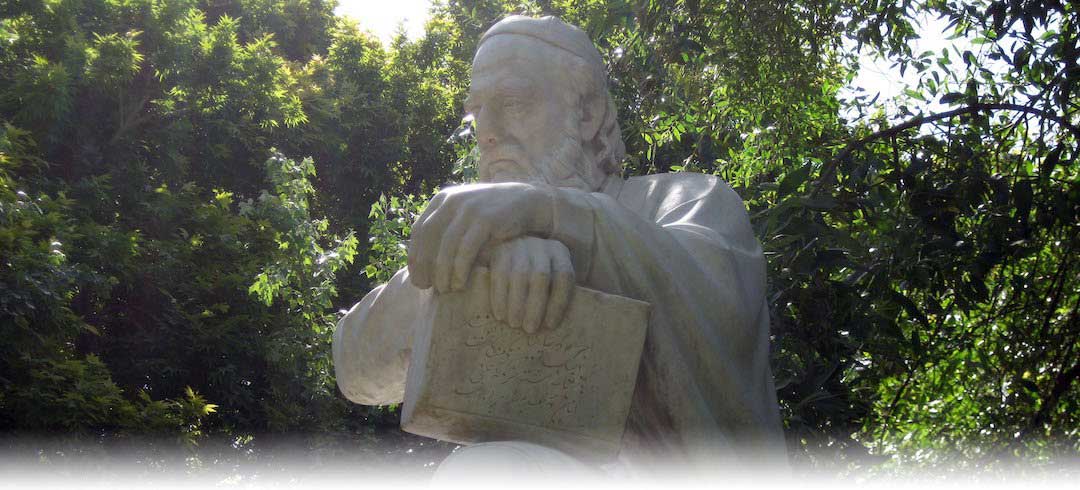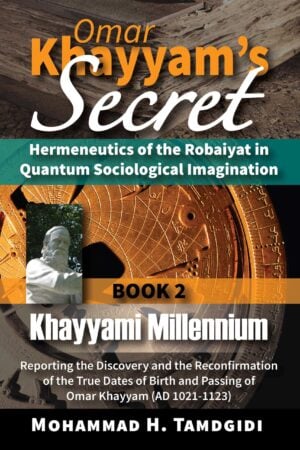Book Section: BACKMATTER — Including the Conclusion to “Omar Khayyam’s Secret” Series: Book 7: Khayyami Art — by Mohammad H. Tamdgidi
$20.00
This includes the conclusion and backmatter of Book 7 of the Omar Khayyam’s Secret series. The essay, titled “Conclusion to Book 7: Summary of Findings,” serves as the conclusion to the book Khayyami Art: The Art of Poetic Secrecy for a Lasting Existence: Tracing the Robaiyat in Nowrooznameh, Isfahan’s North Dome, and Other Poems of Omar Khayyam, and Solving the Riddle of His Robaiyat Attributability, which is the sixth volume of the twelve-book series Omar Khayyam’s Secret: Hermeneutics of the Robaiyat in Quantum Sociological Imagination, authored by Mohammad H. Tamdgidi.
Description
Abstract
This includes the conclusion and backmatter of Book 7 of the Omar Khayyam’s Secret series.
The essay, titled “Conclusion to Book 7: Summary of Findings,” serves as the conclusion to the book Khayyami Art: The Art of Poetic Secrecy for a Lasting Existence: Tracing the Robaiyat in Nowrooznameh, Isfahan’s North Dome, and Other Poems of Omar Khayyam, and Solving the Riddle of His Robaiyat Attributability, which is the seventh volume of the twelve-book series Omar Khayyam’s Secret: Hermeneutics of the Robaiyat in Quantum Sociological Imagination, authored by Mohammad H. Tamdgidi.
In this conclusion, Tamdgidi overviews the basic contributions of the past and present books of the series, offering a detailed synopsis of the chapters of its Book 7 included in the present volume.
In Book 7, Tamdgidi shares his updated edition of Khayyam’s Persian book Nowrooznameh (The Book on Nowrooz), and for the first time his new English translation of it, followed by his analysis of its text. He then visits recent findings about the possible contribution of Khayyam to the design of Isfahan’s North Dome. Next, he shares the texts and his new Persian (where needed) and English translations and analyses of Khayyam’s other Arabic and Persian poems. Finally, he studies the debates on the attributability of the Robaiyat to Omar Khayyam.
Tamdgidi verifiably shows that Nowrooznameh is a book written by Khayyam, arguing that its unreasonable and unjustifiable neglect has prevented Khayyami studies from answering important questions about Khayyam’s life, works, and his times. Nowrooznameh is primarily a work in literary art, rather than in science, tasked not with reporting on past truths but with creating new truths in the spirit of Khayyam’s conceptualist view of reality. Iran in fact owes the continuity of its ancient calendar month names to the way Khayyam artfully recast their meanings in the book in order to prevent their being dismissed (given their Zoroastrian roots) during the Islamic solar calendar reform underway under his invited direction. The book also sheds light on the mysterious function of Isfahan’s North Dome, revealing it as having been to serve as a space, as part of an observatory complex, for the annual Nowrooz celebrations and leap-year declarations of the new calendar. The North Dome, to whose design Khayyam verifiably contributed and in fact bears symbols of his unitary view of a world created for happiness by God, marks where the world’s most accurate solar calendar of the time was calculated. It deserves to be named after Omar Khayyam (not Taj ol-Molk) and declared as a cultural world heritage site. Nowrooznameh is also a pioneer in the prince-guidance books genre that anticipated the likes of Machiavelli’s The Prince by centuries, the difference being that Khayyam’s purpose was to inculcate his Iranian and Islamic love for justice and the pursuit of happiness in the young successors of Soltan Malekshah. Iran is famed for its ways of converting its invaders into its own culture, and Nowrooznameh offers a textbook example for how it was done by Khayyam.
Most significantly, however, Nowrooznameh offers by way of its intricately multilayered meanings the mediating link between Khayyam’s philosophical, theological, and scientific works, and his Robaiyat, showing through metaphorical clues of his beautiful prose how his poetry collection could bring lasting spiritual existence to its poet posthumously. Khayyam’s other Arabic and Persian poems also provide significant clues about the origins, the nature, and the purpose of the Robaiyat as his lifelong project and magnum opus.
Tamdgidi argues that the thesis of Khayyam’s Robaiyat as a secretive artwork of quatrains organized in an intended reasoning order as a ‘book of life’ serving to bring about his lasting spiritual existence can solve the manifold puzzles contributing to the riddle of his Robaiyat attributability. He posits, and in the forthcoming volumes of this series will demonstrate, that the lost quatrains comprising the original collection of Robaiyat have become extant over the centuries, such that we can now reconstruct, by way of solving their 1000-piece jigsaw puzzle, the collection as it was meant to be read as an ode of interrelated quatrains by Omar Khayyam.
Recommended Citation
Tamdgidi, Mohammad H. 2024. “BACKMATTER — Including the Conclusion to “Omar Khayyam’s Secret” Series: Book 7: Khayyami Art.” Pp. 677-824 in Omar Khayyam’s Secret: Hermeneutics of the Robaiyat in Quantum Sociological Imagination: Book 7: Khayyami Art: The Art of Poetic Secrecy for a Lasting Existence: Tracing the Robaiyat in Nowrooznameh, Isfahan’s North Dome, and Other Poems of Omar Khayyam, and Solving the Riddle of His Robaiyat Attributability. (Human Architecture: Journal of the Sociology of Self-Knowledge: Vol. XX, 2024. Tayyebeh Series in East-West Research and Translation.) Belmont, MA: Okcir Press.
Where to Purchase Complete Book: The various editions of the volume of which this Book Section is a part can be ordered from the Okcir Store and all major online bookstores worldwide (such as Amazon, Barnes&Noble, Google Play, Apple, and others).
Read the Above Publication Online
To read the above publication online, you need to be logged in as an OKCIR Library member with a valid access. In that case just click on the large PDF icon below to access the publication. Make sure you refresh your browser page after logging in.








